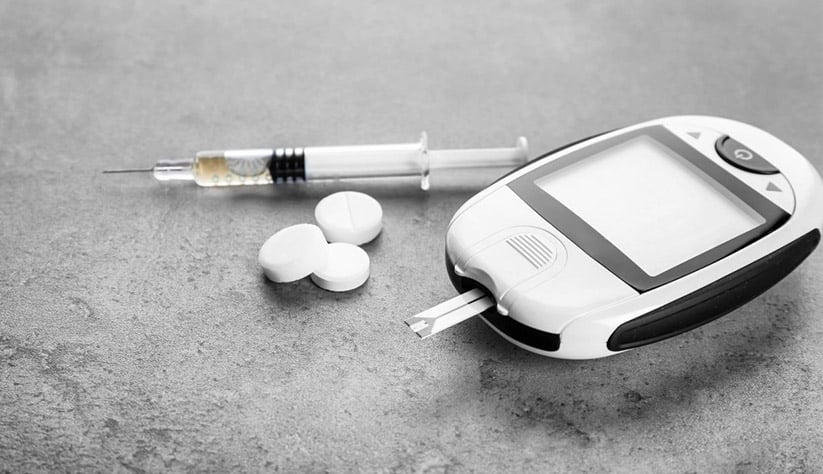
As we enter flu season, people with diabetes are statistically at an increased risk compared to other individuals for everything from the common cold to more dangerous viral infections. This is due to the fact that immunity and metabolic health are very closely linked. That's why we've put together a list of 10 diabetes tips and tricks to help out people with diabetes during flu season (and they're pretty helpful during the rest of the year too!)
Why Is It Helpful To Have Diabetes Guidelines?
It's not just during flu season that it's helpful to have some convenient rules and ideas to follow to stay healthy. In fact, keeping a set of guidelines is an important part of what the ADA (American Diabetes Association) calls "diabetes self-management education", which is a key step in improving your health if you're living with diabetes.
Guides Your Daily Diabetes Care
The first way that these guidelines improve your self-medical care is by helping you to stay on top of your diabetes medication, nutrition, and exercise routine.
Managing your blood glucose levels throughout the day can be hard and intensive, even with diabetes technology like your insulin pump, glucose-lowering drugs, rapid-acting insulin, and other diabetes management tools.
Add in changing diet and exercise, along with the stresses of work, and you can basically be stuck spending your entire day chasing optimal blood glucose values -- which is enough to exhaust anyone!
Getting your system under control takes some of that stress away.
Avoid Short Term Complications
Another reason that it's important to have clear methods of diabetes management is that these guidelines help you to avoid the risky diabetes complications that can come with high blood glucose.
Short-term spikes in blood glucose can cause everything from the 3 P's of diabetes -- polydipsia (excessive thirst), polyuria (excessive urination), and polyphagia (excessive hunger) -- to more dangerous complications like diabetic ketoacidosis and diabetic shock.
Keeping to the right guidelines can help keep these dangerous complications from happening.
Prevent Long Term Risks Like Heart Disease and Chronic Kidney Disease
In addition to preventing dangerous health complications in the short term, keeping to a proven set of guidelines can also help prevent the long-term complications of diabetes.
Even if your blood glucose doesn't spike high enough to cause problems in the immediate turn, prolonged diabetes can increase your risk of diabetes complications like cardiovascular disease and chronic kidney failure.
Your body and blood vessels simply aren't built to function at that high of a blood glucose level and can take all manner of different damage.
Reverse Insulin Resistance, Prediabetes, and Type 2 Diabetes and Drastically Improve Your Quality of Life
And one of the most powerful health outcomes you can see if you take charge and organize your diabetes care is that you can actually reverse the root cause of prediabetes and type 2 diabetes, known as insulin resistance!
With type 1 diabetes, type 1.5 diabetes, or insulin-dependent type 2 diabetes, this means making your body as insulin sensitive as possible, meaning that you can reduce your daily insulin requirements, avoid more intensive treatment, and live a more independent life in full control of your blood glucose.
With prediabetes and non-insulin-dependent type 2 diabetes, it can mean reversing these conditions entirely, eliminating diabetes medications, and bringing your blood glucose levels down so that you can stop putting yourself at risk for diabetes complications.
Either way, the results also include getting rid of diabetes symptoms like excessive thirst, frequent urination, and constant hunger (no more diabetes munchies!), and getting your levels and A1c down to more controllable, healthy levels.
Save Money!
And finally, the biggest reason to follow a series of guidelines is that it can save you money!
If you're living with diabetes, then diabetes medications are probably a part of your daily life.
And if not, keeping to the guidelines can help prevent diabetes symptoms so that you don't have to run out and get prescriptions for them!
That means less money at the pharmacy or drug store -- which is always nice, and it also prevents needing to spend more money on intensive glucose control and medical care or risking the extensive costs of cardiovascular disease and diabetes' more dangerous health outcomes.
And when the average person with diabetes spends $16,750 a year on diabetes care and management, that's definitely something worth adding to your personal manual.
A Word About the American Diabetes Association
The American Diabetes Association has a number of guidelines for Diabetes Self-Management Education, as well as for Healthcare Professionals and Clinical Practice, which have been refined and carefully recommended after thousands of studies and clinical trials.

This series of guidelines are produced and distributed year after year by the ADA's Preventive Services Task Force and is a great resource if you're trying to understand the conventional treatment/medical care in diabetes.
However, this extensive medical and scientific document can be a bit meaty to get into if you're the average person, which is one of the reasons we've got our own series of guidelines as part of the Mastering Diabetes Method!
A Quick Introduction to the Mastering Diabetes Method
The Mastering Diabetes Method is an applied set of guidelines based on almost 100 years of evidence-based research pointing to the root cause of insulin resistance, caused by excess intramyocellular lipids. Our guidelines come from an overwhelming amount of research and are translated into a series of easy-to-understand steps that you can follow throughout your daily life.
The Increased Risks of Flu Season If You're Living with Diabetes
And why is it so important to think about this? In addition to the less-than-ideal health outcomes diabetes can have like cardiovascular disease, people with diabetes mellitus have been shown to have an increased risk for viral infection.
This happens for two reasons. First, people with diabetes may have reduced blood flow to their extremities along with nerve damage, which can make it easier to get an infection.

The second is the fact that a high-blood-glucose environment has been shown to allow bacteria to multiply faster.
Whether it's the common cold, a bacterial infection, influenza, or a more dangerous infection like Covid-19, diabetes is linked to an increased risk for getting sick -- and that's not something anyone wants.
That's why we've put together 10 tips to stay healthy during flu season if you're living with diabetes!
Our 10 Tips Before Flu Season
1. Swap High-Fat Foods for Low-Fat, Plant-Based, Whole-Foods.
Our first step is to lower your fat intake. But not just lower your fat intake and instead consume sugary, low-fat foods. Absolutely not. This is about swapping for nutrient-dense, low-fat, whole foods.
This is the foundation of the Mastering Diabetes Method and this action will have a cascade of positive benefits.
This means replacing foods such as meat and chicken with hearty vegetables such as sweet potatoes, yams, and butternut squash. Or legumes such as red lentils, black beans, and chickpeas. Or intact whole grains such as millet, farro, or quinoa.
This also means reducing your intake of high-fat plant-based ingredients such as nuts, seeds, and avocado. It’s essential to be cognizant of how much fat you're eating from yellow light foods to ensure you’re keeping your fat intake under 15% of total calories per day.
2. Find Fun Fall Reasons to Eat a Plant-Based Diet
One of the best ways to take full control of your diabetes health is to eat a plant-based diet. In fact, research has shown that type 2 diabetes can actually be reversed through a low-fat, plant-based diet.
That's why we've included this diabetes tip as one of our top ten tips for flu season.
And one way to help yourself follow that kind of diet is by finding fun fall reasons and ways to eat more plants -- like healthy fall recipes such as fun smoothie bowls, tasty smoothies, vegetable autumn stew, hearty potato bowls, and butternut buddha bowl with black beans.
There are tons of fun options, and as long as they're part of a low-fat, plant-based, whole-food diet, you're taking the right steps!
3. Consider Immune Boosting Foods
Another step that can help during the fall and winter months is to consider immune boosters.
Vitamin D supplementation, for example, has been shown in clinical studies to help with diabetes prevention as well as reduce the cardiovascular risk associated with diabetes.
Zinc is another supplement that can have a great impact on diabetes AND your immunity. Clinical trials have shown that zinc supplementation can help reduce diabetes-related complications and even improve insulin sensitivity, so it's worth considering!
And one of our favorites is Amla Green Immunity! You may not have heard of amla, but in the coming years you will — it’s one of the most powerful natural antioxidants on the planet, and the team over at Amla Green have combined it with green tea, elderberry, and both of the above nutrients for maybe the most powerful immune booster on the planet.
These are just the start, and in fact, there's an entire class of nutrients that can help your immunity, which includes…
4. Seek Out Foods High in Antioxidants
Everyone knows that antioxidants are great for you, but not everyone knows what they actually do.
And the secret to this family of natural nutrients actually comes down to something called free radicals.
Free radicals are unstable, highly reactive molecules that can cause a lot of damage to cells and tissues if they're not controlled. Antioxidants work by neutralizing free radicals before they have the chance to create any more damage!
So why does this help your immunity? Well, your body's natural immune response creates a lot of free radicals. Keeping on top of your antioxidants can help keep these free radicals under control, so your body can focus on fighting infection.
Add in the fact that antioxidants are tied with a number of other benefits like diabetes prevention AND diabetes control, and you've got a great reason to eat your antioxidant-rich foods!
5. Adjust Your Exercise to the Weather
Moving onto some good habits to keep during the winter months, the first is to adjust your exercise routine due to the change in weather.
If you're used to going out for a swim or a jog during the summer months, it's possible that your diabetes might make this more difficult during the fall and winter.
On the other hand, the fall and winter months might also bring new activities outdoors, like skiing, hiking or, even leaf-viewing!
Either way, diabetes management is important to take into consideration when you're thinking about your exercise routine! People with diabetes can be more sensitive than other people when it comes to hypoglycemia and low blood sugar during wintertime, so that's important for us.
The best thing you can do if you're exercising? Make sure that you check your blood glucose before your workout.
If possible, it's best to eat a small snack that includes some protein 30 minutes - an hour before working out so you have enough energy for whatever activity you're doing!

6. Enjoy Hot Tea or Black Coffee on an Intermittent Fast
And if you're on the way back from a stroll outside or a beautiful autumn bike ride (or even if you're just getting ready for the day), you can enjoy a cup of hot tea or black coffee as part of intermittent fasting!
Intermittent fasting has been well-documented as a great way to get your blood sugar back on track and improve your insulin sensitivity.
Not only are you limiting the hours in which you eat (making it easier to monitor your glucose), but intermittent fasting also causes healthy weight loss (great for diabetes prevention) and improves your immunity.
The key here is a process called autophagy, or cell recycling, which happens during extended periods of calorie restriction.
Autophagy is the process that your cells use to clean themselves out, remove damaged proteins, burn fat reserves, and generally stay healthy!
Intermittent fasting combined with hot tea or coffee (calorie-free drinks!) is a great way to embrace the fall while you're taking your diabetes care to an even better level.
7. Consider Splurging on Continuous Glucose Monitoring
And if you're having a bit of trouble keeping your levels on track, continuous glucose monitors can be a great early-self-Christmas present.
Continuous glucose monitoring means that you wear a device on your skin that can constantly monitor how much glucose is in your blood and increase your time in range (TIR).
Since diabetes puts people at risk for hypoglycemia (low blood sugar events) and hyperglycemia (high blood sugar events), continuous monitoring really helps to keep an eye out and make sure everything's okay!
Think of it as getting your own diabetes assistant - someone who just follows you around all day, making sure that your diabetes is being taken care of!
8. Check-in With Your Diabetes Care Team
This is another tip we can't emphasize enough. Your diabetes care team is there for you throughout your journey living with diabetes, and if you haven't checked with them in a while, it's worth dropping them a line!
Apart from helping you understand your unique challenges, your diabetes care team can also help you plan on how to adjust your diabetes management plan for the changing season.
That can mean adjusting your diabetes care products (like insulin) or even just giving you tips on how to adjust your diet.
9. Remember You're Not Alone

And one of the most important tips we can give to anyone living with diabetes is to remember that you're not the only one.
Even if diabetes is your number one challenge in life, there are thousands of other people out there living with diabetes - and they're getting through it every day!
There's a whole community behind you who can help support you on this journey. So don't be afraid to reach out for support from the people around you.
10. Take Control with the Mastering Diabetes Method!
And if you're looking to take your diabetes control to the next level, we've got great news for you!
The Mastering Diabetes Method is designed specifically for people with diabetes (in all its various forms) who are looking to get their diabetes under control ASAP, and it can adapt to your specific needs.
Whether it's through diet and lifestyle changes or medication/insulin, this method can help anyone take control of diabetes - and get their blood sugar back on track!
Think of it like having that Preventive Services Task Force speaking to you in layman's terms. You're getting the simple, easy steps of diabetes care, and it's all right there for the taking!
Coaches Are At the Ready, Are You?
There's a reason we recommend the Mastering Diabetes Method -- it works!
And we're not just talking about the thousands of studies that went into creating this method.
We're talking about the thousands of real people who have already taken control of their lives, and experienced what we like to call an "A1c Miracle."
We want to help as many people as we possibly can, and diabetes coaches are standing by ready to provide you with personalized support.
If diabetes is your number one challenge right now (don't worry - it's not yours alone!), our diabetes experts will teach you how to take control of diabetes today, no matter what life throws at you.
Because right now, before the minefield that is flu season and the holidays, we can all use as much help as possible!
Lower Your A1c and Get to Your Ideal Body Weight ... Guaranteed

Your results are guaranteed. Join more than 10,000 ecstatic members today
Personalized coaching puts you in immediate control of your diabetes health, helps you gain energy, improves your quality of life, and reduces or eliminates your meds.




